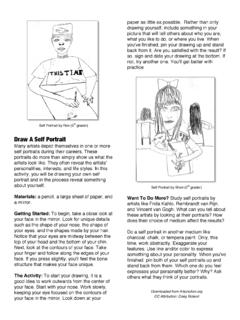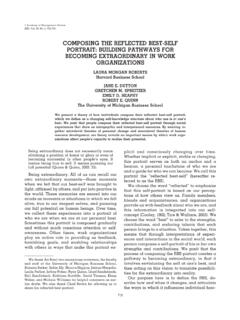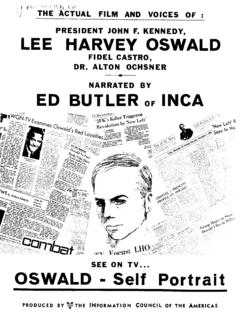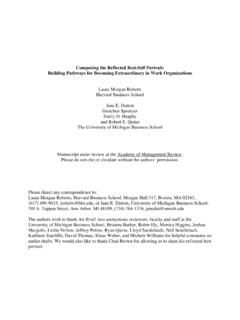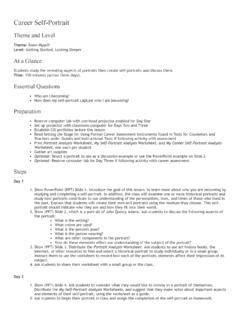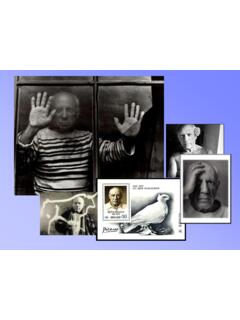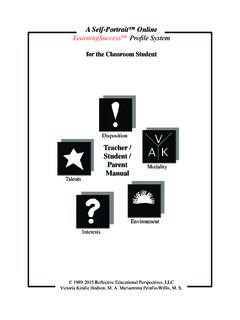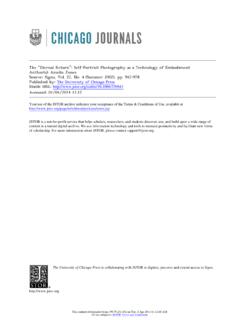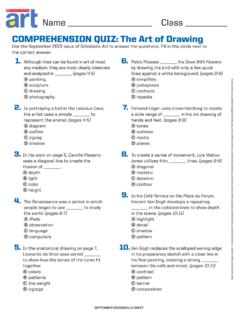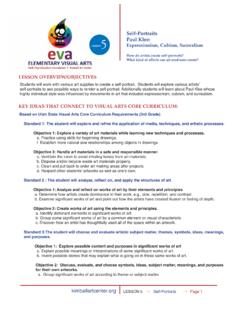Transcription of STREET ART/GRAFFITI SELF-PORTRAITS
1 STREET ART/GRAFFITI self -PORTRAITSA imee CarmellaA high school unit plan focusing on how visual artists use images, symbols, and words to convey meaning. Background/IntentWith a background in both creative design and art education, I find that I draw on my strengths as a designer when I create lesson plans. Developing a lesson that is worthy of my student s time and creative energy is paramount. I want the student s end result the work of art created or simply their process of experimentation to be meaningful and worthwhile. I treat my work as a designer in the same manner. I want to make meaning with what I create. I solve problems to get to where I need to be with a design I develop. Formulating lesson plans becomes a puzzle that I need to organize and design so that the message reads clearly and resonates with what I am trying to express. When I design lessons to use in the classroom, I begin with a complex idea and break it down into lessons that scaffold upon one another.
2 I feel that since students will be picking up several skills ( , how to correctly photograph another student s portrait , how to use Photoshop to alter an image, etc.), I want each lesson to be self -contained, having the strength to stand on its own. There should be a clear point to each lesson that is achievable so that students are set up for success. Designing a series of lessons in such a way that they can build knowledge and skill and work toward the larger goals that time to try to design a lesson that will draw students in because of the materials used or the concepts or techniques presented. This establishes a hook that allows for the rigid walls of the classroom to dissolve and creates a designed environment where creativity can thrive and students can develop a passion for what they are ART/GRAFFITI self -portraitsDesigned by Aimee CarmellaEssential QuestionsWhen does art become vandalism?
3 When does vandalism become art?What makes an image so powerful?Unit Grade Levels 9th - 12th GradesTime Span3 - 90 minute lessons with one additional hour-long work period if this unit, students will familarize themselves with STREET ART/GRAFFITI - style art culture, the artists such as Banksy, Keith Haring, and Basquiat who were/are known for their STREET art, and will discuss the implications of making this controversial art. Students will look at political campaign posters of the past (Obama Hope poster), as well as war propaganda images and discuss power of image. Students will develop an understanding of how visual artists use symbols and words to convey meaning. Building on this knowledge, students will photograph each other in headshot style and edit photographs in Photoshop to create high contrast black and white images that will be printed and traced onto acetate and stencilled onto a canvas.
4 They will add layers to their canvas via additional stencils, and words or a slogan that they identify with which positively demonstrates environmental, political, or social relevency. Maine StudentLearning ResultsLesson 1 Lesson 2 Lesson 3A1- Artist s Purpose (9-12)A3 - Media Tools Tech. & Processes (9-12)B1 - Media Skills (9-12)D1 - Aesthetics & Crit. (9-12)E2 - Arts & Other Disciplines (9-12)E5 - Interpersonal Skills (9-12)D1 - Aesthetics & Criticism (9-12)Evidence of PerformanceAbility to question why an image can be powerful. Ability to discuss differences between vandalism and STREET what a slogan is/ represents. Ability to manipu-late a photograph in to work with layers of pattern and media in design, responds thoughtfully to most note written - Elem. of Art & Princ. Des. (9-12)A3 - Media Tools Tech. & Processes (9-12)B1 - Media Skills (9-12)B3 - Making Meaning (9-12)A1 - Artist s Purpose (9-12)A2 - Elem.
5 Of Art & Princ. Des. (9-12)A3 - Media Tools Tech. & Proc. (9-12) B1 - Media Skills (9-12)B2 - Composition SkillsB3 - Making Meaning (9-12)C1 - Appl. of Creative Proc. (9-12)D1 - Aesthetics & Criticism (9-12) STREET ART/GRAFFITI Background - Lesson 1 What makes an image so powerful?Provoking QuestionsWhat is graffiti / STREET Art?What makes an image so powerful?What is the difference between a graffiti wall and a mural?What does simplification do to an image?Lesson Objectives+ Students will examine environmental, historical and social factors that influence graffiti artists / political cam-paign designers and their work.+ Students will take headshots of one another using knowledge of composition and lighting and save image virtually to be used for next + Computers (1 per student or can be shared in small groups)+ Digital Camera, tripod (optional) - 1 per group of two students + Photoshop or other photo editing software+ Projector for projection of slideshow images (visual provocations)+ (Optional) hats or scarvesVocabulary+ graffiti + STREET Art+ High Contrast+ Headshot+ self -portraitVisual ProvocationsExamples of local graffiti art if possible, Banksy, Christo, Basquiat, Keith Haring, Political Posters.
6 Instruction1. Begin class with a slide show. First image: (Banksy) Is this art? (Yes - why? No - why?) Have students brainstorm why art is public or private. Ask: what kinds of art are public? Sculpture? Large-scale art such as murals? Advertisements? graffiti ? Show slide examples such as Christo s fabric installation pieces, Keith Haring s subway art, and Banksy s guerilla art? What influences these artists? How do you think they decide what to create? (Important historical issues, current events, environmental issues, pop cul-ture references, etc.) How about political campaign art? We see examples like Obama s Hope campaign poster. Why do you think this poster was important? (Creates a brand, well composed, unique design, easy 1 word slogan to remember.) Here, this poster becomes a symbol - something that we will remem-ber and that stands for something. 2. We are going to be creating our own posters that take from what we are studying in this class that will be composed of a self portrait that we will modify in Photoshop to create a high-contrast image and even-tually layer into a graffiti d poster.
7 Today we will work on taking a headshot of one another, and next class we will start working on creating stencils to use on our poster from the headshot and other Instruct students how to use camera (DSLR) to take pictures. If possible, have every camera set up on a tripod. Go through steps about avoiding backlighting if there are windows. Have students take 4 or 5 different shots that they will then upload to their personal drive and let them know that next class they will choose one of those shots. Students can wear hat and/or scarf to create some visual interest. Discuss composition and go over rule of thirds. Let them know that they will be creating high contrast black and white images from these photos. + Lowbrow art+ Highbrow art+ Guerilla art+ Propaganda+ Visual Expression4. By end of class, students should have uploaded all images to their drive and if time allows, decide which image they will choose for their self - portrait .
8 5. Before class time is over, quickly go over what will happen next class: a. Going over how to modify your portrait in Photoshop b. Using Threshold, Cutout filters in Photoshop c. Printing an 11 x17 image d. Going over how to trace image onto acetate using a lightbox. 6. Homework prompt will be given out upon dismissal from classroom to be returned next UpCameras turned off, placed in camera bags. Tripods folded and put away. Computers logged + Students will have each produced a viable headshot. + Homework prompt provided to students (see attached). Modifications+ Teacher can take photos of students if there is a lack of cameras. + Students can bring in a photo of themselves if they prefer after class + Computers + Photoshop+ Digital-SLR camerasVisual ProvocationsVisual ProvocationsVisual Provocations courtesy Aimee CarmellaName _____ Date_____Identify a STREET artist whose work is powerful and describe what makes his/her work ART/GRAFFITI Background - Lesson 2 What makes an image so powerful?
9 Provoking QuestionsWhen we use technology to replicate an image over and over again, does the image s value diminish?When we use technology to replicate an image over and over again, does it then become original to the recreator? Why create a slogan?ObjectivesThe learner will understand and demonstrate the use of filters in learner will understand the concept of slogan and develop one to use in their self + Computers (1 per student or can be shared in small groups)+ Photoshop or other photo editing software+ Light Box+ Acetate or stencil paper+ X-acto knife with a cutting surface+ Permanent marker for tracing onto acetate+ 11 x17 Printer paper + Large sheet of paper for demo stepsVocabulary + Posterize+ Contrast+ High Contrast+ Negative Space+ Positive Space+ self -portraitVisual Provocation Teacher example during demo (see attached screenshots)Instruction1. Collect exit slips from last class.
10 All students should be sitting where they can view photoshop demonstration (in front of LED projector). Teacher instructs that they will be creating high-contrast versions of their self portraits that they took during last class. Teacher shows them the steps (which are also written on a large paper in easily viewed location in classroom) to creating their own high-contrast portrait . Students are encouraged to take their time with figuring out how they want their portraits to look. The threshold/posterize/blur amounts can be tweaked on an individual basis. Tip: It should be emphasized that the negative-spaces that compose the features in the self portrait need to stay intact, and there shouldn t be any small islands of white details. These areas will not be successfully transferred during the stencilling process since they have no connector to larger black areas.
